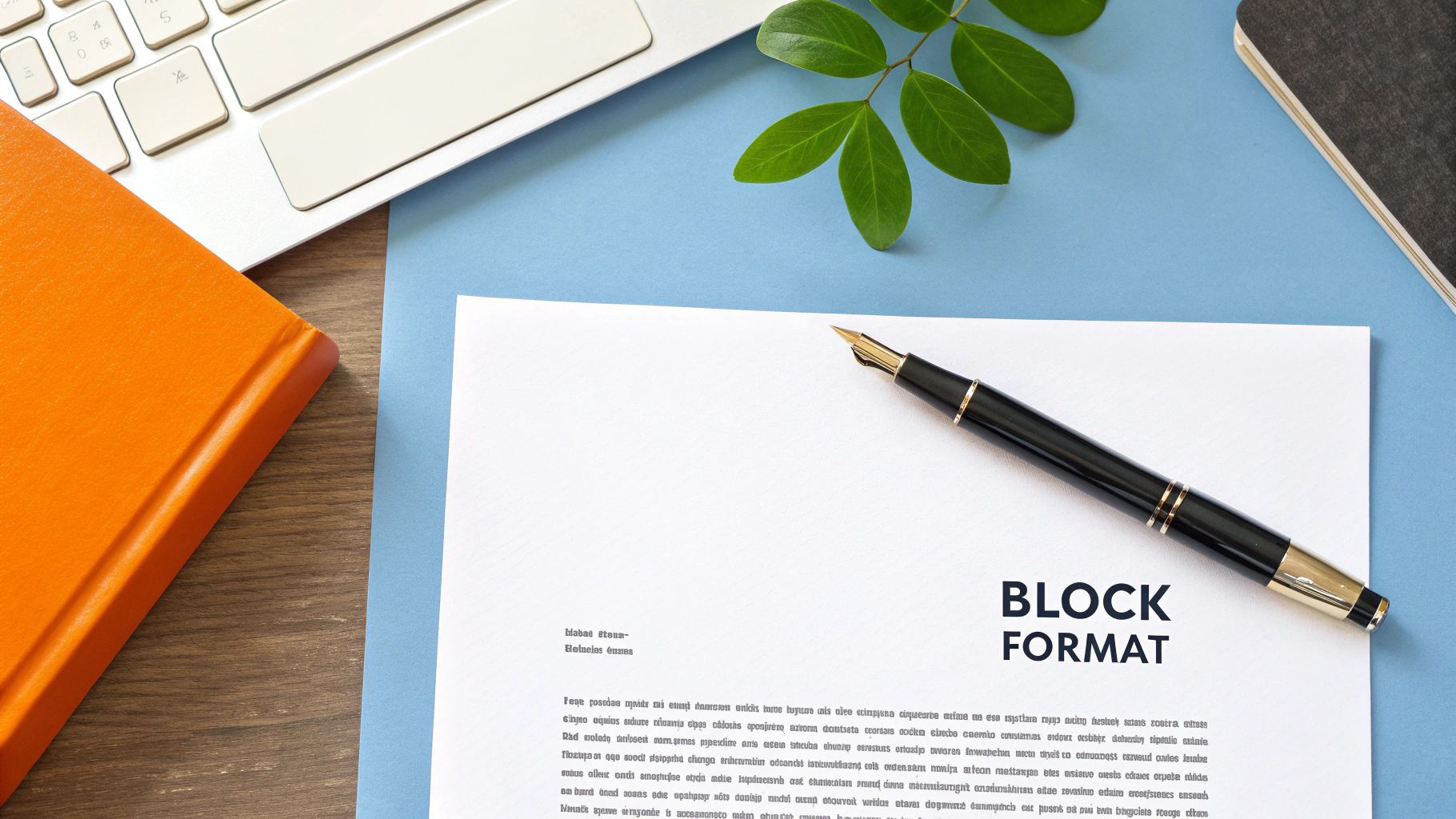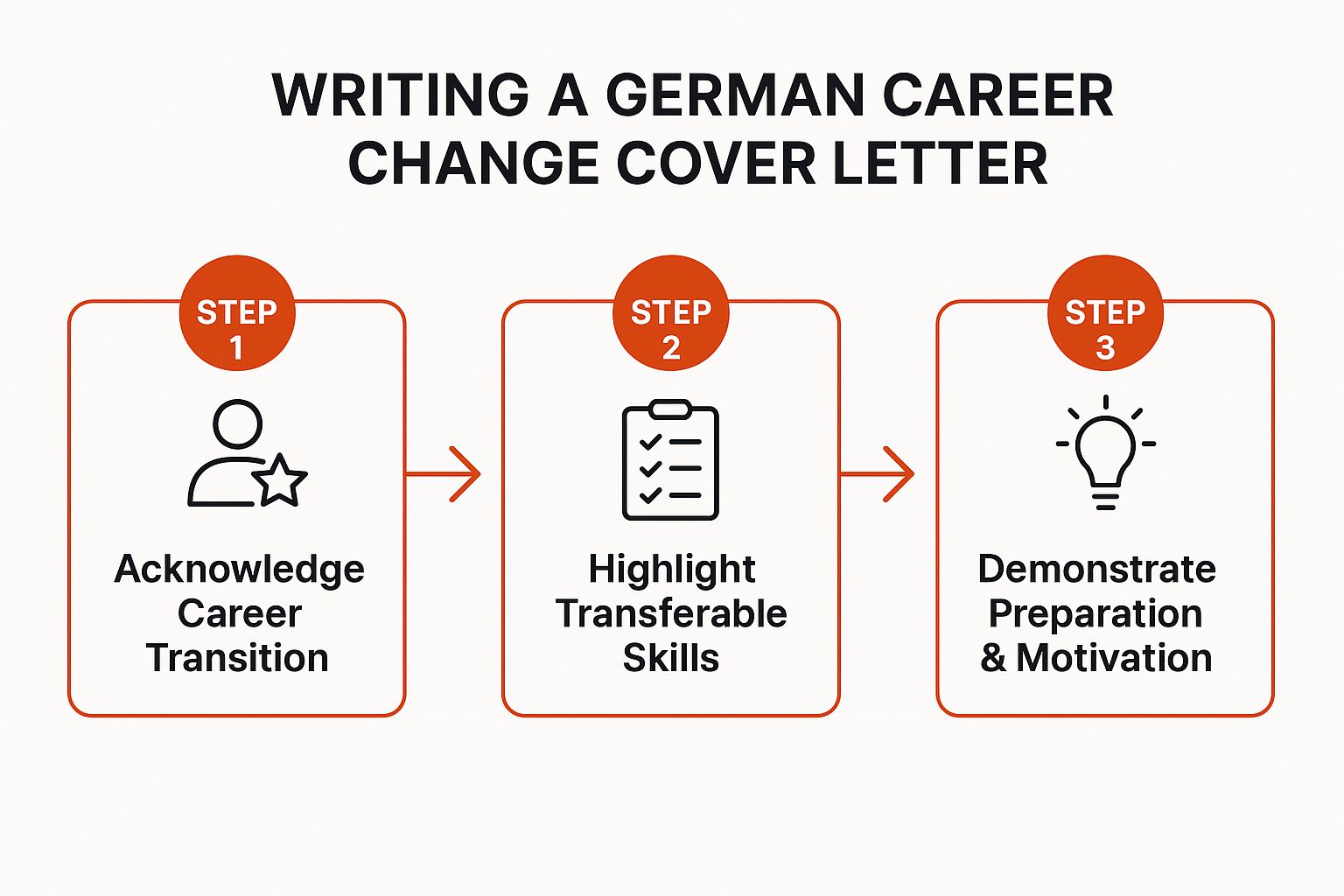Crafting a compelling cover letter, or 'Anschreiben', is a critical step in navigating Germany's formalised job market. While the rules can seem rigid, understanding the nuances of communication and structure is what separates a successful application from a rejected one. This guide moves beyond generic templates to provide a strategic breakdown of essential german cover letter examples, each tailored for a specific career scenario. We will dissect the structure, analyse the professional tone, and extract actionable tactics to help you write a cover letter that not only meets but exceeds the expectations of German recruiters.
This is not just a collection of samples; it is a tactical manual designed to show you why certain phrases work and how to adapt them for your own professional story. We will analyse what makes each example effective, from the precise opening sentence to the confident closing statement. From traditional industries to dynamic startups, these insights will equip you to present your qualifications with precision and impact. Mastering these conventions ensures your application gets the serious consideration it deserves, moving you one step closer to your next career opportunity in Germany.
1. The Traditional German Block Format Cover Letter
The cornerstone of any German job application is the traditional block format cover letter, or Anschreiben. This format adheres to strict DIN 5008 standards for business correspondence, presenting a clean, organised, and highly professional appearance. Its rigid structure is not just a suggestion; for many German employers, particularly in conservative sectors, it is an expectation that signals your attention to detail and respect for formal business culture. This format is non-negotiable for applications in banking, law, government, and traditional manufacturing.

Strategic Breakdown
The block format is all about precision. The sender's address is placed at the top, followed by the recipient's full address aligned to the left. The date is right-aligned, and the subject line (Betreff) is bolded and clearly states the position and reference number. This meticulous structure allows a hiring manager to quickly scan for essential information without any distraction.
Key Insight: The layout itself is the first test. A perfectly formatted letter shows you are diligent and understand German professional norms. Deviating from this standard can be perceived as careless or even disrespectful, potentially disqualifying your application before it is even read.
Why This Format Excels
This format is the gold standard because it communicates professionalism and seriousness. It is universally recognised and respected by German HR departments and career services like the Arbeitsagentur.
- Clarity and Efficiency: It allows recruiters to process applications quickly, as they know exactly where to find key details.
- Demonstrates Cultural Fit: Using this format correctly shows you have done your homework and are prepared to integrate into a German corporate environment.
- Sets a Professional Tone: The formality of the layout immediately establishes a respectful and serious tone for your application.
Actionable Takeaways
To correctly implement one of the most vital German cover letter examples, follow these specific rules:
- Font and Margins: Use a standard, professional font like Arial or Times New Roman in 11-12pt. Maintain standard margins (e.g., 2.5 cm on the left, 2 cm on the right).
- Formal Salutation: Always use the formal salutation, “Sehr geehrte/r Herr/Frau [Last Name],”. Never use a generic greeting; research the specific contact person.
- Signature: End with a formal closing like “Mit freundlichen Grüßen” followed by your handwritten signature (if sending a physical copy) and your typed name.
- Keep it to One Page: Brevity is key. Your entire argument for why you are the best candidate must fit concisely onto a single A4 page.
2. The Modern German Motivational Cover Letter
While the traditional format remains essential, a more contemporary approach is gaining traction, particularly in modern, dynamic sectors. The motivational cover letter, or Motivationsschreiben, focuses less on rigid formality and more on showcasing your personality, passion, and cultural fit. It weaves a compelling narrative about why you are drawn to that specific company and role, moving beyond a simple list of qualifications. This style is highly effective for applications to tech startups, creative agencies, and international companies with a modern corporate culture.

Strategic Breakdown
The motivational letter builds upon the professional foundation of the traditional format but infuses it with personal drive. It answers the crucial question: "Why us?". You connect your personal story and career aspirations directly to the company's mission, values, or recent projects. For instance, you might reference a specific campaign by a marketing firm or a new product launch by a tech company like Zalando to demonstrate genuine, well-researched interest.
Key Insight: This format allows you to differentiate yourself in a crowded applicant pool. By showing you understand the company’s "why" and connecting it to your own, you transform from just another qualified candidate into a passionate and potentially ideal colleague.
Why This Format Excels
This approach is powerful because it establishes an emotional and intellectual connection with the recruiter. It is a key reason this format is found in many modern German cover letter examples.
- Demonstrates Proactive Interest: It proves you have invested time in researching the company beyond its homepage, showing initiative and genuine enthusiasm.
- Highlights Cultural Alignment: By discussing company values or mission, you signal that you are not just looking for any job, but for a place where you will thrive and contribute meaningfully.
- Showcases Personality: It provides a platform to reveal your personality and work ethic in a way a standard CV cannot, which is crucial for roles requiring strong teamwork and communication skills.
Actionable Takeaways
To craft a compelling motivational cover letter, you must blend professionalism with authentic storytelling:
- Research Deeply: Go beyond the "About Us" page. Look into recent press releases, social media activity, or employee testimonials on platforms like Kununu to find specific points of connection.
- Connect to Your Story: Use a storytelling approach. For example, “Having followed your sustainability initiative for the past year, I was inspired by [specific achievement], which aligns with my own work in [your related experience]…”
- Quantify Your Passion: Back up your motivation with data. Link your enthusiasm to past successes, e.g., “My passion for user-centric design led me to increase user engagement by 30% in my previous role at [Company X].”
- Maintain Professionalism: While more personal, the tone must remain professional. Avoid overly casual language and ensure the document is perfectly proofread and still adheres to basic business letter formatting.
3. The German Career Change Cover Letter
Transitioning between careers, or making a Quereinstieg, is becoming more common in the German job market, but it requires a specialised approach. The career change cover letter is strategically designed to address a recruiter's primary concern: why is this candidate switching fields, and are they genuinely prepared? This format directly tackles potential doubts by framing the career change as a deliberate, motivated decision, rather than a sign of instability. It is essential for professionals moving from unrelated fields, such as a teacher entering corporate training or an engineer moving into product management.
Strategic Breakdown
Unlike a standard application, this letter's narrative must bridge the gap between your past experience and your future role. It starts by acknowledging the transition upfront in a positive light. The core of the letter then focuses on mapping your existing transferable skills (übertragbare Fähigkeiten) directly to the requirements of the new position, proving your value despite a non-traditional background.
Key Insight: German employers value stability and clear career progression. A career change letter must proactively build a logical and compelling narrative that justifies the shift, demonstrating deep reflection, research, and commitment to the new professional direction.
The following infographic illustrates the core three-step process for structuring your narrative.

This process flow visualises how to turn a potential weakness, the career change itself, into a convincing argument for your candidacy.
Why This Format Excels
This targeted approach is crucial because it neutralises recruiter skepticism. It shows you are not just applying randomly but have a well-thought-out plan.
- Builds a Compelling Narrative: It transforms your diverse background from a potential liability into a unique strength.
- Highlights Transferable Skills: It forces you to identify and articulate how skills like project management, communication, or analytical thinking from a previous role apply directly to the new one.
- Demonstrates Motivation: A well-crafted letter proves your commitment by showing the concrete steps you have taken, like certifications or networking, to prepare for this new path. Explore more career development strategies by reading these articles about professional growth on iKnowly.
Actionable Takeaways
To create persuasive German cover letter examples for a career change, focus on building a strong, logical argument:
- Address the “Why” Head-On: Begin your letter by stating your motivation for the career change. Frame it positively, focusing on newfound passion or the desire to apply your skills in a new context.
- Create a Skills Bridge: Explicitly connect your past experiences to the job description. For example, "My experience in managing classroom dynamics has honed my ability to lead diverse teams and facilitate corporate training sessions effectively."
- Show, Don’t Just Tell: Mention concrete evidence of your commitment. This could be relevant courses you have completed, industry events you have attended, or informational interviews you have conducted in the new field.
- Use Industry Language: Demonstrate your familiarity with the target industry by using its specific terminology and referencing current trends or challenges. This shows you have done your homework.
4. The German Academic/Research Position Cover Letter
When applying for positions at universities, research institutes like Max Planck or Fraunhofer, or corporate R&D departments, a specialised academic cover letter is required. This format blends the strictness of the DIN 5008 standard with the unique conventions of scholarly communication. It is designed to foreground your academic credentials, research expertise, and intellectual contributions, proving you are a serious and capable member of the German research community.
Strategic Breakdown
The academic cover letter, or Bewerbungsschreiben für eine akademische Stelle, maintains the formal structure of a German business letter but shifts the content focus entirely to your research profile. Instead of highlighting business achievements, you must detail your research projects, publications, funding successes, and methodological skills. The letter must explicitly connect your specific research interests and past work to the projects and goals of the hiring institution or professor.
Key Insight: In German academia, your application is a testament to your scholarly rigour. The letter must demonstrate not only your qualifications but also your deep understanding of the specific research field and the institution's contribution to it. Generic statements are an immediate red flag.
Why This Format Excels
This format is essential because it speaks the language of German academia, a world with its own distinct culture and priorities. It is the standard expected by academic hiring committees and research leaders.
- Demonstrates Specialised Fit: It allows you to prove you are not just a general applicant but a specialist whose research aligns perfectly with the institution's agenda.
- Highlights Scholarly Merit: The structure prioritises publications, conference presentations, and research methodologies, which are the primary currencies of academic success.
- Shows Institutional Awareness: A well-crafted letter proves you have thoroughly researched the department, its faculty, and its current research projects, signalling genuine interest.
Actionable Takeaways
To create one of the most effective German cover letter examples for an academic role, integrate these elements:
- Mention Specific Research: Refer directly to the work of the professor or research group you are applying to join. Explain how your own research complements or extends theirs.
- Quantify Achievements: State your number of publications, list key journals, mention specific grants you have won, and name the research tools and methodologies you have mastered (e.g., SPSS, MATLAB, qualitative content analysis).
- Clarify Credentials: If your degrees are from outside Germany, mention their German equivalents (e.g., a PhD is equivalent to a Doktortitel). Include your Common European Framework of Reference for Languages (CEFR) level for German (e.g., C1).
- Structure Your Argument: Dedicate distinct paragraphs to your research experience, your methodological skills, and your motivation for joining that specific institution. Ensure your passion for the subject is evident.
5. The German Apprenticeship (Ausbildung) Cover Letter
Applying for a German apprenticeship, or Ausbildung, requires a specific type of cover letter. Unlike applications for senior roles, this letter focuses on potential, motivation, and a genuine interest in hands-on learning rather than extensive professional experience. This format is crucial for school leavers, career changers, and anyone entering Germany's renowned dual education system, which combines practical training with vocational schooling. It is the standard for securing positions at companies like Volkswagen, local Sparkasse banks, and countless small to medium-sized enterprises (Mittelstand).

Strategic Breakdown
An Ausbildung cover letter must prove you are a worthy investment. Companies are not just hiring an employee; they are taking on a trainee they will develop over several years. The letter must demonstrate maturity, reliability, and a clear understanding of why you have chosen this specific apprenticeship and company. You need to connect your personal interests, school performance, and any practical experience (even hobbies) to the requirements of the role.
Key Insight: Your enthusiasm and personality are your biggest assets. Employers look for candidates who are genuinely excited about the trade and show a proactive attitude towards learning. This is your chance to show who you are beyond grades and a CV.
Why This Format Excels
This specialised format is effective because it directly addresses the unique expectations of apprenticeship recruiters, who are guided by bodies like the German Chamber of Commerce (IHK). It shifts the focus from what you have done to what you can and want to do.
- Highlights Potential: It allows you to showcase your raw talent, learning agility, and passion, which are often more important than a long work history.
- Shows Commitment: A well-researched letter proves you are serious about the three-to-four-year commitment and understand the career path ahead.
- Demonstrates Proactiveness: It signals that you have thoroughly researched the company and the profession, a key trait for a successful apprentice.
Actionable Takeaways
To craft one of the most effective German cover letter examples for an apprenticeship, concentrate on these details:
- Link Hobbies to Skills: If applying for an IT apprenticeship, mention your experience building a PC or coding a small project. For a mechanic role, talk about working on cars or bikes.
- Connect School Subjects to the Job: Highlight high marks in subjects relevant to the apprenticeship, such as maths for a banking role or physics for a technical position.
- Express Clear Motivation: State exactly why you want this specific Ausbildung at this particular company. Mention their training programme, company values, or products.
- Maintain Formality: Despite the focus on personality, you must still adhere to the formal DIN 5008 structure, including a formal salutation and closing. Understanding these nuances is especially important for international applicants; you can find out more about German work and training visa requirements to ensure you are fully prepared.
6. The German Executive/Leadership Cover Letter
For senior management and C-suite roles, the German executive cover letter is a strategic document that balances formal tradition with a powerful display of leadership and commercial acumen. It moves beyond listing skills to demonstrating high-level strategic thinking, quantifiable achievements, and a clear vision for the company's future. While it respects the formal structure of a standard Anschreiben, its content is tailored to influence board members and executive search firms by showcasing significant business impact. This format is crucial for CEO, Managing Director, and VP applications.
Strategic Breakdown
The executive letter's primary goal is to present a candidate as a strategic partner, not just a prospective employee. It must articulate a deep understanding of the company's market position, challenges, and opportunities. The language is confident and direct, using metrics-driven evidence of past successes to build a compelling case for future value creation. This involves detailing leadership in transformations, market expansions, or significant financial turnarounds.
Key Insight: This is less of an application and more of a business proposal. The letter must answer the unspoken question from the board: "Why should we entrust a significant part of our organisation to you?" Your vision and proven ability to execute are the core of your argument.
Why This Format Excels
This specialised format is effective because it speaks the language of the boardroom and addresses the high-stakes nature of executive appointments. It is designed to capture the attention of experienced leaders and decision-makers.
- Demonstrates Strategic Vision: It proves you think beyond day-to-day operations and can contribute to the company's long-term strategic direction.
- Builds Immediate Credibility: Using specific, high-impact metrics (e.g., "Grew market share by 15%," "Led a €50M cost-saving initiative") establishes you as a results-oriented leader.
- Aligns with German Business Culture: It shows respect for formal structures while demonstrating the decisiveness and authority expected of senior leaders in Germany.
Actionable Takeaways
To craft one of the most persuasive German cover letter examples for a leadership role, focus on high-level impact:
- Quantify Everything: Translate your leadership accomplishments into concrete numbers. Focus on revenue growth, cost savings, market share, and team performance improvements.
- Showcase Industry Expertise: Demonstrate a sophisticated understanding of the German and European markets, including regulatory landscapes and competitive dynamics.
- Lead with Your Vision: Open with a powerful statement about how your leadership will specifically address the company's strategic goals or overcome its current challenges.
- Leverage Your Network: Mentioning relevant board positions or high-level connections can be powerful. Understanding the nuances of professional networking in Germany is a distinct advantage.
Comparison of 6 German Cover Letter Types
| Cover Letter Type | Implementation Complexity 🔄 | Resource Requirements ⚡ | Expected Outcomes 📊 | Ideal Use Cases 💡 | Key Advantages ⭐ |
|---|---|---|---|---|---|
| Traditional German Block Format | Medium – requires precise formatting and strict structure | Moderate – standard office tools, formatting knowledge | Professional, formal impression; widely accepted in traditional industries | Banking, government, legal, manufacturing sectors | Universally accepted; respects business culture; clear template |
| Modern German Motivational | High – needs extensive company research and customization | High – time investment for personalization and data gathering | Engaging, personalized impression; shows cultural fit and motivation | Startups, tech firms, creative agencies, modern consultancies | Differentiates from generic letters; shows genuine interest |
| German Career Change | High – requires strategic explanation and customization | High – time for preparing transferable skills evidence and motivation | Addresses employer skepticism; highlights adaptability and commitment | Professionals switching industries or roles | Proactively manages concerns; highlights unique perspective |
| German Academic/Research | Medium-High – demands academic detail and proper terminology | Moderate-High – requires detailed academic documentation | Clear demonstration of scholarly qualifications and research fit | Universities, research institutes, corporate R&D | Emphasizes research achievements; tailored for academia |
| German Apprenticeship (Ausbildung) | Low-Medium – simple structure focusing on motivation | Low – basic resources, emphasis on educational background | Shows learning potential and commitment; appropriate for entry-level | Apprenticeship applicants, school leavers, career changers | Highlights motivation and vocational understanding |
| German Executive/Leadership | High – requires strategic, quantified achievements and polish | High – gathering validated metrics and leadership examples | Showcases leadership, vision, and business impact suitable for senior roles | CEOs, managing directors, board members, VPs | Demonstrates senior-level impact; emphasizes strategic vision |
Your Next Step: From Example to Application
You have now explored the nuanced world of German cover letters, from the formal structure of the traditional block format to the persuasive narrative required for a career change. The german cover letter examples we have analysed throughout this guide are not just templates; they are strategic blueprints designed to navigate the expectations of German hiring managers.
By dissecting these examples, a clear pattern of success emerges. Mastering this professional document is less about following a rigid formula and more about understanding a cultural and professional framework. It is a blend of respecting established conventions while confidently articulating your unique value proposition.
Synthesising Key Principles for Success
Let's distill the most critical takeaways that apply across all the examples, whether you are applying for an apprenticeship or an executive role. Your ability to integrate these principles will fundamentally determine the impact of your application.
- Structure is Non-Negotiable: The German emphasis on order and precision is directly reflected in the Anschreiben. Adhering to the correct format (contact details, date, subject line, formal salutation) is the first test of your professionalism and attention to detail.
- Personalisation is Paramount: Generic, one-size-fits-all letters are immediately dismissed. Your letter must demonstrate a genuine interest in the specific company and role. Mentioning company projects, values, or recent achievements shows you have done your research.
- Evidence Trumps Claims: Do not just state that you are a "team player" or "results-driven". Prove it. Use the "Problem-Action-Result" model to quantify your accomplishments with concrete numbers, percentages, and tangible outcomes. This is the most powerful way to substantiate your skills.
Turning Theory into Action
Understanding these concepts is the first step; applying them effectively is the next. Before you begin writing, revisit the specific example from this article that most closely aligns with your career situation. Use it as a structural guide, but ensure the content is entirely your own and tailored to the job you are targeting.
Your German cover letter is your first and best opportunity to make a compelling case for your candidacy. It sets the tone for your entire application, demonstrating not only your qualifications but also your understanding of German business etiquette. A well-crafted letter that is formal, personalised, and evidence-based does more than just secure an interview; it positions you as a serious, culturally-aware professional who is ready to contribute from day one.
Are you ready to ensure your cover letter meets the high standards of the German job market? Get personalised, 1:1 feedback on your application from industry professionals at top German companies through iknowly. Connect with experts from Siemens, BMW, and more to refine your message and perfect your pitch. Book your consultation on iknowly today and take the final step towards landing your dream job in Germany.

Leave a Reply